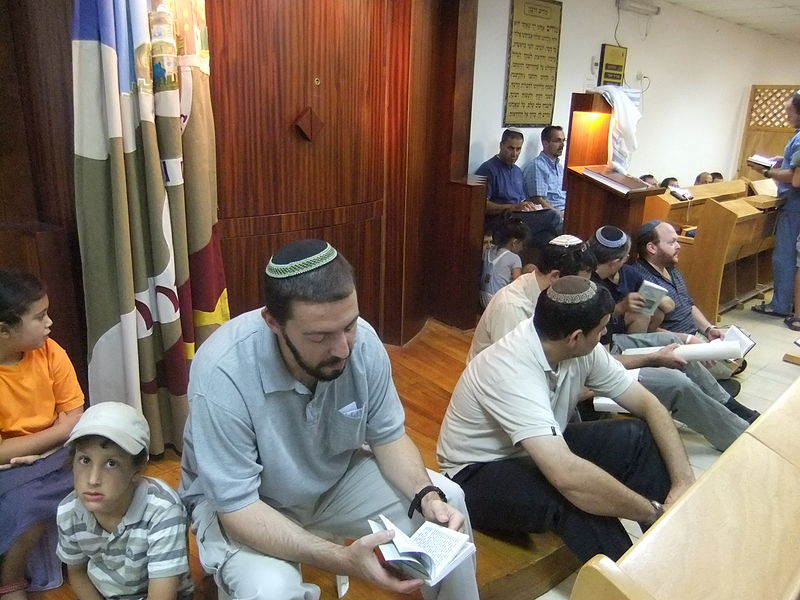
Rosh Chodesh Av – the first day of the Hebrew month of Av – begins the most intense mourning period of The Three Weeks. This nine-day mourning period culminates in the fast of Tisha B’Av.
Tisha B’Av is a Rabbinic fast day that occurs on 9 Av. This day is a day of fasting and commemorating the multiple tragedies that have occurred on this day, most notably the destruction of the First and Second Temples.
Tisha B’Av is the culmination of a three week period of increasing mourning, beginning with the fast of the 17th of Tammuz, which commemorates the first breach in the walls of Jerusalem, before the First Temple was destroyed.
During this three week period, weddings and other parties are not permitted, and people refrain from cutting their hair. From the first to the ninth of Av, it is customary to refrain from eating meat or drinking wine (except on Shabbat) and from wearing new clothing.
The restrictions on Tisha B’Av include refraining from eating and drinking (even water); washing, bathing, shaving or wearing cosmetics; wearing leather shoes; engaging in sexual relations; and studying Torah. Work in the ordinary sense of the word is also restricted. Many of the traditional mourning practices are observed: people refrain from smiles, laughter and idle conversation, and sit on low stools. In synagogues, the Book of Lamentations is read and mourning prayers are recited. The ark (cabinet where the Torah is kept) is draped in black.
Five tragedies (Taanit 26b)1 that have befallen the Jewish people on this date are:
Decree that the Hebrews would not enter Eretz Yisrael (Shemot 14:26-36)2
Destruction of the First Beit HaMikdash (Yirmiyahu 39:1-2; Divrei Hayamim Beit 36:17-20)2
Destruction of the Second Beit HaMikdash (Josephus The War of the Jews, Book VII)3
Betar was captured (Gittin 57a)4
Yerushalayim was razed (Josephus The War of the Jews, Book VII)3
The last of the five events of Tisha b’Av can be interpreted along the same lines. The final razing of Jerusalem was designed to quash any hopes among the Jews for a restoration of their sovereignty, or even of their ability to dwell in the city. Once again, on the very date which marked the Jewish people’s original spurning of Eretz Yisrael, Eretz Yisrael was showing its own scorn for the Jewish people. (Ta’anit 29a)1
Other tragedies have also occurred on Tisha B’Av in the modern era.5
In 1095 the First Crusade was declared by Pope Urban II resulting in 10,000 Jews killed in first month of Crusade and nearly the total obliteration of many communities in Rhineland and France.
In 1290, the Jews were expelled from England, their sacred texts and writings were destroyed and their property was confiscated.
The Spanish Inquisition culminated with the expulsion of the Jews from Spain in 1492.
World War I broke out on the eve of Tisha B’Av in 1914. German resentment from this war set the stage for the Shoah.
On Tisha B’Av eve 1942, the mass deportation of Jews from the Warsaw Ghetto to Treblinka began.
The deadly bombing of the building of the Jewish community center in Buenos Aires, Argentina killed 86 people and wounded some 300 others in 1994.
Take us back, O Eternal One, to Yourself, and let us come back; renew our days as of old! For truly, You have rejected us, bitterly raged against us. Take us back, O Eternal One, to Yourself, and let us come back; renew our days as of old! (Eichah 5:21-22)2
——————–
1I. Epstein. “Talmud Bavli – Tractate Ta’anit.” [http://halakhah.com/pdf/moed/Taanith.pdf]
2David Stein (ed.). JPS Hebrew-English Tanakh. Philadelphia: The Jewish Publication Society, 1999.
3William Whiston (trans.) Flavius Josephus’ War of the Jews Sacred Texts, 1737. [http://www.sacred-texts.com/jud/josephus/war-7.htm]
4I. Epstein. “Talmud Bavli – Tractate Ta’anit.” [http://halakhah.com/pdf/nashim/Gittin.pdf]
5Mordechai Becher. “History of Events on Tish B’Av.” Ohr Somayach, n.d. [http://ohr.edu/1088]
